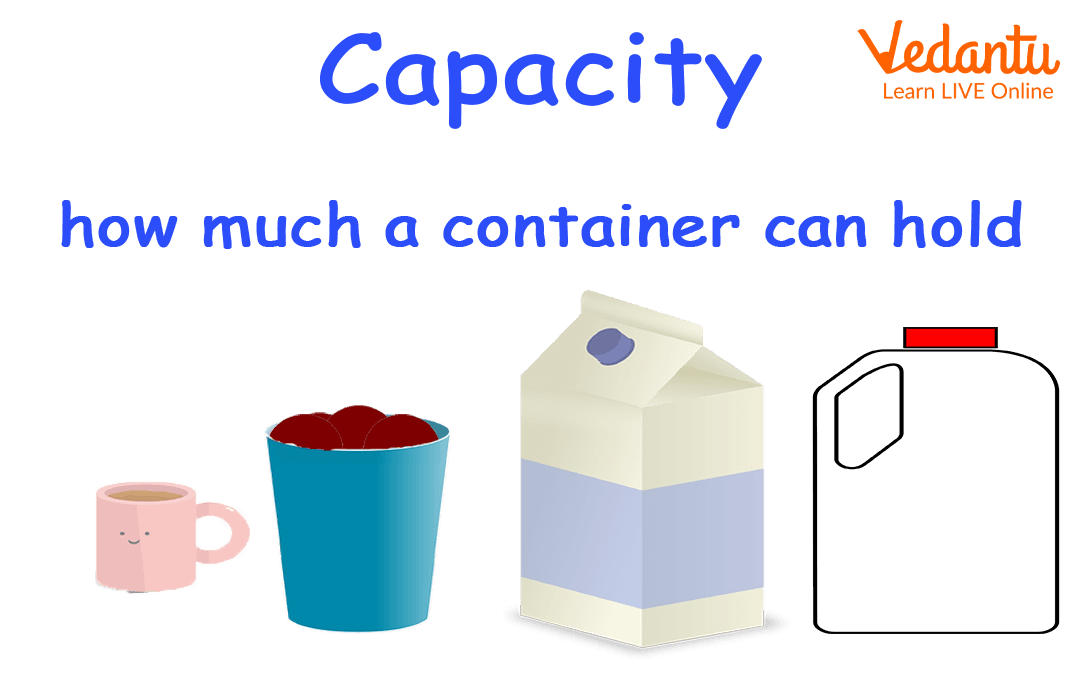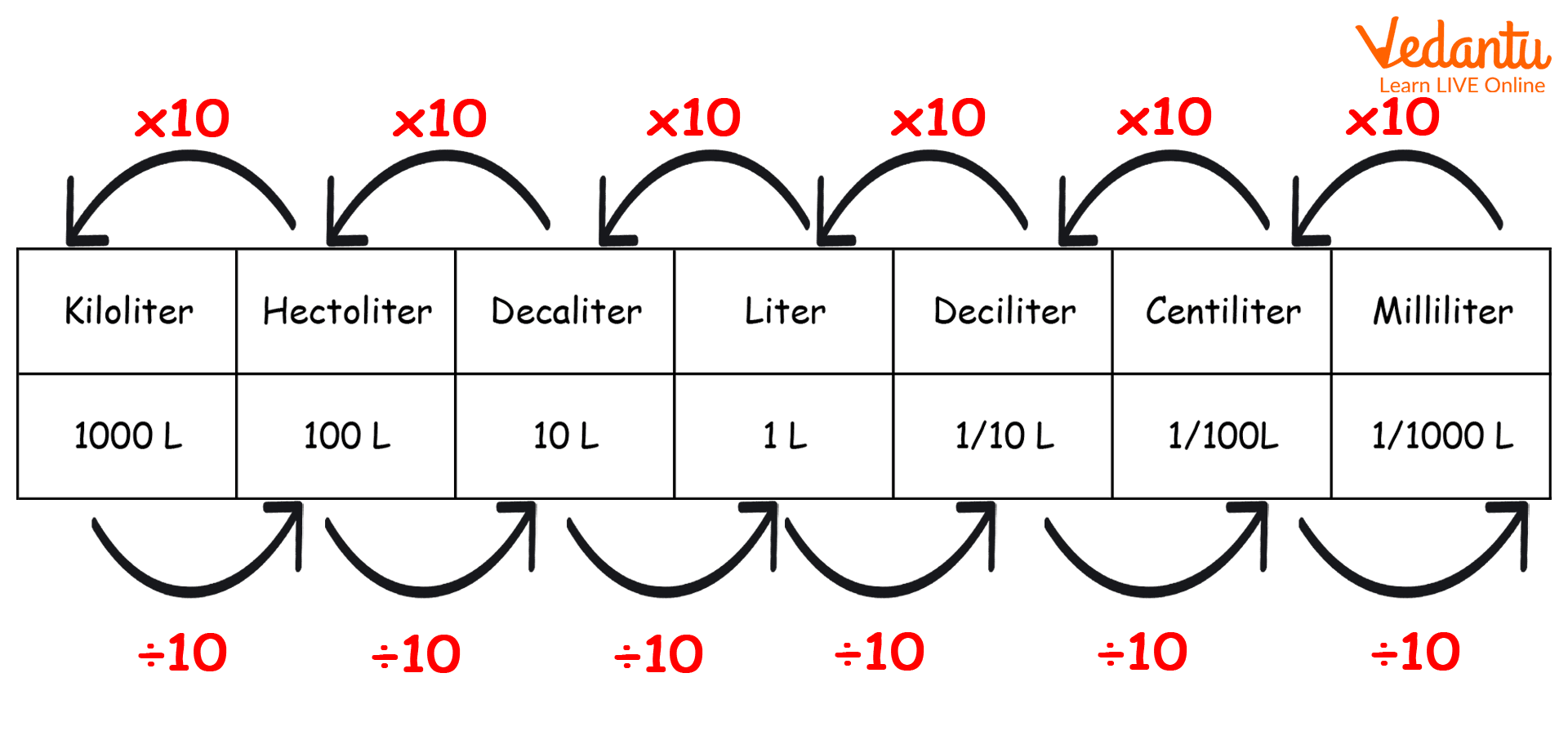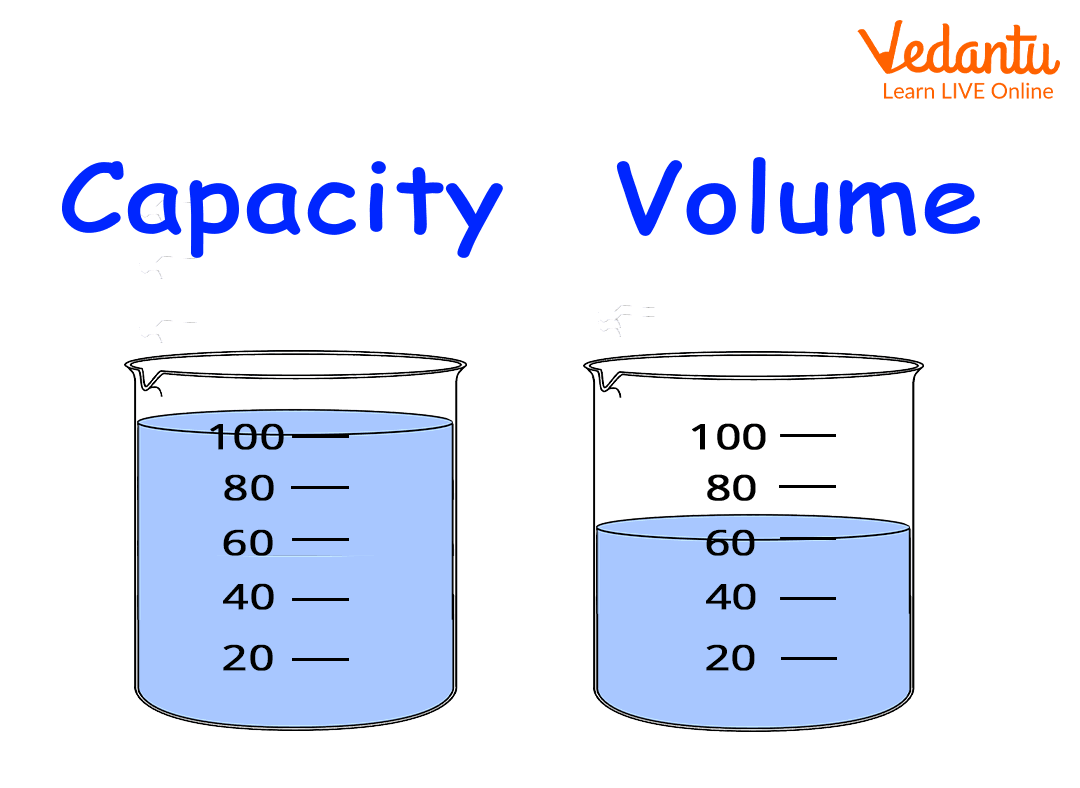




Introduction
Capacity is an important quantity we use to measure liquids. We use different units of capacity daily. Capacity is the amount that can be held in a hollow container. We measure chemicals in millilitres and petrol in litres.
What is Capacity?
Before we learn the units of capacity, let’s first learn what capacity is. Capacity is the amount that can be held in a hollow container. Its unit is a litre. In other words, it refers to the volume of a hollow container. We should keep in mind that volume and capacity are not the same. Volume is measured in cm3, and m3 but capacity is measured in litres or gallons.

Capacity
Unit of Capacity
The SI unit of capacity is litres. But in some places in the world, it is measured in gallons. The short term for litre is L and that for millilitre is ml. Mathematically, 1 litre \[ = \] 1000 millilitres. Below is given the metric chart to convert the units of capacity.

Metric chart
Difference between Capacity of a Container and Volume of Liquid in it
Volume of a liquid in a container refers to the total amount of space covered by an object in a three-dimensional space. Whereas, capacity is the amount of matter that can be held by a hollow object. For example, volume of a liquid in a container is the amount of liquid present in a container, while the capacity is the maximum amount of liquid that can be held by the same container. All three-dimensional shapes have volume whether they are solid or hollow, whereas only hollow three-dimensional shapes can have capacity otherwise they would not be able to hold any liquid or matter within themselves. To find the capacity of a hollow shape we need its volume, we pour a liquid into the hollow shape till it's full and then we can conclude that the capacity of the container is equal to the volume of liquid in it.

Capacity of a container versus Volume of liquid in a container
Converting Litre into \[{\rm{c}}{{\rm{m}}^3}\]
It is very important to know how to convert units of volume of liquid between litres and \[{\rm{c}}{{\rm{m}}^3}\]. We know that 1 litre is equal to 1000 \[{\rm{c}}{{\rm{m}}^3}\]. So if the volume of water in a pot is 5 litres then it has a volume of 5000\[{\rm{c}}{{\rm{m}}^3}\].
Great, We have learned about capacity and volume of an object. We have successfully understood the meaning of capacity and the difference between volume and capacity of shapes and containers. We learned how to convert the units of capacity into the metric system. And we know how to convert Litre into \[{\rm{c}}{{\rm{m}}^3}\] and vice versa.
Conclusion
Capacity is commonly used to measure the amount of liquid in a container. It is important to know how much 1 litre is and its other units. We also learned the conversion of different units of capacity. And also understood that volume and capacity are not the same.
Solved Examples
1. What is the capacity of a hollow cuboid of dimensions 10 cm x 20 cm x 30 cm?
Ans. The volume of the cuboid is 6,000 \[{\rm{c}}{{\rm{m}}^3}\].
We know that 1L \[ = \] 1,000\[{\rm{c}}{{\rm{m}}^3}\]. So the volume of the cuboid is 6 x 1L. Hence 6,000 cm3\[ = \] 6L.
2. Find the volume and capacity (in metric units) of a cube of side length 20 cm.
Ans. The volume of a cube is [side]\[ \times \][side]\[ \times \][side]
Volume \[ = 20 \times 20 \times 20\]\[{\rm{c}}{{\rm{m}}^3}\]
Volume \[ = 8000\]\[{\rm{c}}{{\rm{m}}^3}\]
Now for capacity, we need to convert the \[{\rm{c}}{{\rm{m}}^3}\]
into a litre
We know that 1 L \[ = \] 1000\[{\rm{c}}{{\rm{m}}^3}\]
Hence, capacity \[ = \] 8 litres.
FAQs on Unit of Capacity
1. What exactly is capacity in Maths?
In Maths, capacity refers to the total amount of liquid or any substance that a container can hold. Think of it as the maximum volume a hollow object, like a water bottle, a jug, or a bucket, can contain.
2. What is the standard unit used to measure capacity?
The standard unit of capacity is the Litre (L). For measuring smaller amounts, we commonly use Millilitres (mL). These units help us measure liquids like water, milk, or juice accurately.
3. What is the main difference between capacity and volume?
This is a common point of confusion! Capacity is the total amount a container can hold when it's completely full. Volume is the actual amount of space the substance is currently taking up inside the container. For example, a 1-litre bottle has a capacity of 1 litre, but if it's only half full, the volume of water inside is 500 millilitres.
4. Could you give some real-life examples of capacity?
Certainly! You see capacity all around you every day. Here are a few examples:
- The amount of milk a carton can hold (e.g., 1 Litre).
- The total amount of petrol a car's fuel tank can store (e.g., 40 Litres).
- The quantity of water a bucket can contain for mopping.
- The small amount of medicine a syrup bottle holds (e.g., 100 Millilitres).
5. How do you convert a larger unit of capacity to a smaller one?
To convert from a larger unit to a smaller one, you multiply. The key relationship to remember is that 1 Litre = 1000 Millilitres. So, if you want to convert litres to millilitres, you simply multiply the number of litres by 1000. For example, 3 Litres is equal to 3 x 1000 = 3000 Millilitres.
6. Why is it important to learn about different units of capacity?
Learning about different units like litres and millilitres is important for practical, everyday life. It helps us choose the right unit for the right job. You would use millilitres for a small dose of medicine but litres for the water in a swimming pool. Understanding this helps in cooking, shopping, and making sense of the world around us.
7. Can a solid object, like a stone or a book, have capacity?
No, a solid object like a stone or a book does not have capacity. Capacity is a property of hollow objects because it measures the empty space inside that can be filled. A solid object is already full of its own matter and has no internal space to hold anything else.









